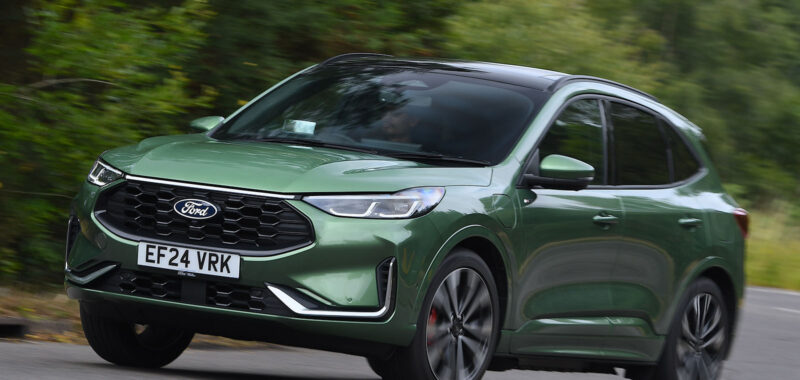Ford’s marketing is keen to push how much ‘more’ this car can do compared to its predecessor, and this philosophy translates inside to a larger screen and more functionality for the infotainment system. However, you arguably get less in terms of hardware, because the HVAC controls have migrated onto the screen, and in their place sits a small row of shortcut buttons for the surround-view cameras, de-mister, and park assist.
The dials which have remained fall easily to hand, though, especially the gearchange which feels tactile to both use and hold.
Cabin quality elsewhere, however, is a mixed bag. Up front, most materials feel good enough, but closer acquaintance throws the cheaper interior plastics into view. The upper door cards, for example, are trimmed in soft-touch artificial leather up front but scratchy plastic in the back.
The doors themselves feel cheap, opening and closing with an unpleasant clang. It comes from the door protector that pops out, which is very useful, but could have been integrated more neatly.
The Kuga pulls one back for occupant space. The front seats have a wide base and good under-thigh support, and there is plenty of adjustment in the driving position. In the back, with the seats reclined, you have the space to really stretch out and, even though our car came with the optional space-robbing panoramic sunroof, we did not struggle for headroom.
Storage space elsewhere is good, with plentiful storage for keys, phones and other clutter. Larger door bins would be helpful, however.
Boot space is reduced for the PHEV from the get-go, falling from 645 litres in the regular models to 581 litres with the seats slid fully forward, but the boot floor does at least conveniently sit flush with the broad boot lip. This compares with 652 litres in the Tiguan e-Hybrid with its seats in the same configuration, or 500 litres for the Toyota RAV4 PHEV.
Ford Kuga infotainment
The centrally-mounted touchscreen is a headline addition for this generation. It sees the introduction of Ford’s SYNC4 infotainment system, which uses a 13.2in touchscreen and is said to offer double the computing power of the SYNC3 system used in the old Kuga.
Overall, the system is more intuitive to use than Volkswagen’s MIB4 effort, but doesn’t have as much functionality, with no ribbon at the top or bottom to which you can add shortcut buttons for its most important features. There is also no rotary controller like that used in the Mazda CX-5, which may have helped in this respect.
But, like Volkswagen’s system, the air conditioning controls permanently sit at the foot of the screen and, once you get used to them, they are easy enough to configure as you please. The buttons can be difficult to hit while you’re on the move, however, and, while the standard-fit Apple CarPlay and Android Auto are easy to connect to, on multiple occasions we experienced some connection issues.
Another gripe is that the indicator ‘tock’ is all but inaudible, especially when you have the radio or air conditioning switched on.

